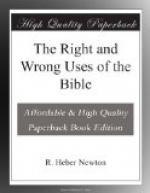“If we have” (in any sense, God speaking in the Bible) “then, of all passages, it is in these, which treat so confidently of futurity, that we must recognize His voice; if we have it not in these passages, then, where are we to listen for it at all?”—Greek Testament III:64.
[30] “History of American Socialisms,”—Noyes.—p. 608.
[31] “To understand that the language of the Bible is fluid, passing and literary, not rigid, fixed and scientific, is the first step towards a right understanding of the Bible.”—Literature and Dogma.—p. xii.
[32] The revised version calls the attention of English readers to this latter influence, in the marginal rendering of “Tartarus” for “Hell” in 2 Peter, 11: 4.
[33] Luther’s strong sense detected his unevangelicalness.
[34] Ewald says the tenth century, and Kuenen the eighth century.
[35] Ask at Abel and at Dan whether the genuine old statutes of Israel have lost their force?—2 Samuel, xx. 18. Restored by Ewald from the LXX.
[36] Such a late codification is no more inconceivable than Justinian’s codification of Roman law.
[37] Brook Foss Westcott. Smith’s Bible Dictionary: article on Daniel.
[38] “The Bible of To-day,” Chadwick, p. 50.
[39] Of this process we see hints in the various references to the consecration of great trees and stones to Jehovah.
[40] The indications of this nature-worship lie scattered on the surface of the Old Testament so plainly that no one can fail to notice them.
[41] “Among the Edomites, Ishmaelites, Ammonites and Moabites—the tribes with which Israel felt itself most nearly related—the service of the rigorous and destroying god was most prominent The very names for God which are most common among them—Baal, El, Molech, Milcom, Chemosh—are enough to show this. These names denote the mighty, violent, death-dealing God.” “The Religion of Israel,” Knappert, p. 29. These names constantly recur in the early history of Israel. Jephthah’s vow is a familiar instance of this abhorrent rite. Circumcision is supposed to mark a merciful compromise with this blood-gift; in addition to its sanitary character.
[42] We know from general history how among other people the homage paid to the productive powers of nature led to systematized prostitution, in the name of the personification of this force of nature. Tradition records how early in this period the Midianites seduced Israel temporarily from Jehovah, by the licentious pleasures of their worship of Baal-Peor. Later on in history we find that it is these impure rites that especially provoke the anger of the prophets.
[43] The sun symbols may not have been permanent features of the Temple-worship at this period, though, from the probable identification of the early Jehovah with the sun, it seems likely that their presence there was no casual fact.




